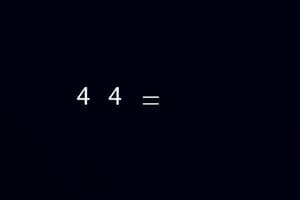Podcast
Questions and Answers
What is a vector?
What is a vector?
- A quantity that only has direction.
- A scalar quantity represented by an arrow.
- A quantity that has both magnitude and direction. (correct)
- A quantity that has neither magnitude nor direction.
How is the magnitude of a 2D vector v = (v₁, v₂) calculated?
How is the magnitude of a 2D vector v = (v₁, v₂) calculated?
- |**v**| = v₁ + v₂
- |**v**| = √(v₁² + v₂²) (correct)
- |**v**| = v₁ * v₂
- |**v**| = √(v₁ + v₂)
Which method can be used to add vectors graphically?
Which method can be used to add vectors graphically?
- Circle method
- Box method
- Tip-to-tail method (correct)
- Square method
What does the dot product of two vectors yield?
What does the dot product of two vectors yield?
How is the cross product of vectors defined?
How is the cross product of vectors defined?
What happens when you multiply a vector by a negative scalar?
What happens when you multiply a vector by a negative scalar?
What is a unit vector?
What is a unit vector?
In vector notation, how is a vector expressed for three dimensions?
In vector notation, how is a vector expressed for three dimensions?
Flashcards are hidden until you start studying
Study Notes
Definition
- A vector is a quantity that has both magnitude and direction.
- Common examples include displacement, velocity, acceleration, and force.
Representation
- Vectors are often represented graphically as arrows:
- The length of the arrow indicates the magnitude.
- The direction of the arrow indicates the direction of the vector.
- Algebraically, a vector can be expressed in component form: v = (v₁, v₂) for 2D or v = (v₁, v₂, v₃) for 3D.
Operations
-
Addition
- Vectors can be added graphically using the tip-to-tail method or mathematically by adding corresponding components.
- If A = (a₁, a₂) and B = (b₁, b₂), then A + B = (a₁ + b₁, a₂ + b₂).
-
Subtraction
- To subtract vectors, reverse the direction of the vector being subtracted.
- A - B = A + (-B).
-
Scalar Multiplication
- A vector can be multiplied by a scalar, changing its magnitude but not its direction (if the scalar is positive).
- If k is a scalar and A = (a₁, a₂), then kA = (ka₁, ka₂).
Magnitude
- The magnitude of a vector v = (v₁, v₂) is calculated as:
- |v| = √(v₁² + v₂²) in 2D.
- |v| = √(v₁² + v₂² + v₃²) in 3D.
Unit Vectors
- A unit vector is a vector with a magnitude of 1.
- It indicates direction only and can be found by dividing a vector by its magnitude.
- Common unit vectors in 2D:
- i = (1, 0)
- j = (0, 1)
Dot Product
- The dot product of two vectors A and B is a scalar and is calculated as:
- A · B = a₁b₁ + a₂b₂ for 2D vectors.
- The dot product is related to the angle θ between vectors by:
- A · B = |A||B|cos(θ).
Cross Product
- The cross product is defined only in three dimensions and yields a vector.
- If A = (a₁, a₂, a₃) and B = (b₁, b₂, b₃), then the cross product is:
- A × B = (a₂b₃ - a₃b₂, a₃b₁ - a₁b₃, a₁b₂ - a₂b₁).
- The resultant vector is perpendicular to both A and B.
Applications
- Used in physics to describe forces, motion, and fields.
- Essential in engineering, computer graphics, and navigation.
Vectors
- A vector is a quantity that has both magnitude and direction.
- Examples include displacement, velocity, acceleration, and force.
- Represented graphically as arrows; the length indicates magnitude and the direction the arrow points is the direction of the vector.
- Can be expressed in component form;
**v** = (v₁, v₂)for 2D or**v** = (v₁, v₂, v₃)for 3D.
Vector Operations
- Addition can be done graphically using the tip-to-tail method or mathematically by adding corresponding components.
- If
**A** = (a₁, a₂)and**B** = (b₁, b₂)then**A** + **B** = (a₁ + b₁, a₂ + b₂) - Subtraction involves reversing the direction of the vector being subtracted. `A - B = A + (-B).
- Scalar Multiplication involves multiplying a vector by a scalar, which changes its magnitude but not its direction (if the scalar is positive).
k**A** = (ka₁, ka₂).
Vector Magnitude
- The magnitude of a vector is calculated by using the Pythagorean theorem:
|**v**| = √(v₁² + v₂²) in 2D|**v**| = √(v₁² + v₂² + v₃²) in 3D.
Unit Vectors
- Unit vectors have a magnitude of 1, indicating direction only, and are found by dividing a vector by its magnitude.
- Common unit vectors in 2D:
- i = (1, 0)
- j = (0, 1)
Dot Product
- The dot product is a scalar.
- Calculated as:
**A** · **B** = a₁b₁ + a₂b₂for 2D vectors. - Measures the "projection" of one vector onto another.
**A** · **B** = |**A**||**B**|cos(θ).
Cross Product
- Defined only in three dimensions and yields a vector.
- If
**A** = (a₁, a₂, a₃)and**B** = (b₁, b₂, b₃)then the cross product: **A** × **B** = (a₂b₃ - a₃b₂, a₃b₁ - a₁b₃, a₁b₂ - a₂b₁).- The resultant vector is perpendicular to both A and B.
Vector Applications
- Used in physics to describe forces, motion, and fields.
- Essential in engineering, computer graphics, and navigation.
Studying That Suits You
Use AI to generate personalized quizzes and flashcards to suit your learning preferences.




